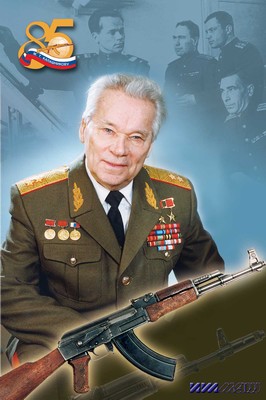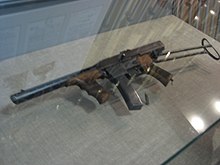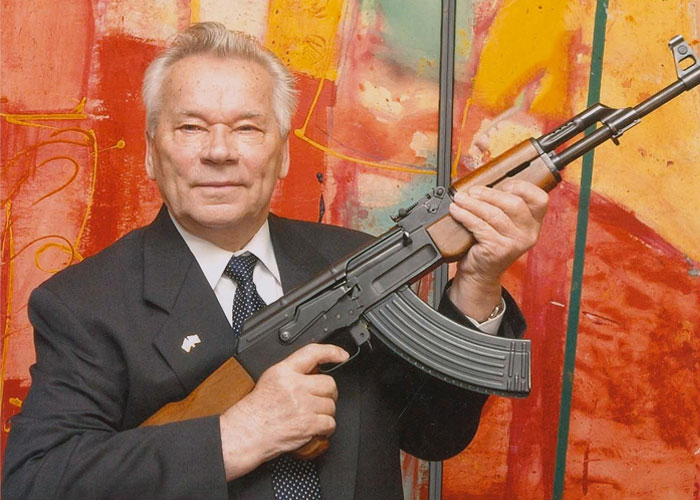
توفى "ميخائيل كلاشنيكوف" مصمم السلاح الأسطورى "كلاشنيكوف" عن عمر يناهز 95 سنة بعد صراع طويل مع المرض الخطير، وفى يوم 17 نوفمبر كان كلاشنيكوف فى العناية المركزة.
ميخائيل كلاشنيكوف

الفريق ميخائيل تيموفييفيتش كَلاشْنِكوف، (Russian: Михаи́л Тимофе́евич Кала́шников, Mihail Timofeevič Kalašnikov) عسكري ومخترع روسي عرفه العالم من خلال السلاح الرشاش الذي اخترعه ويعرف باسمه.
ولد ميخائيل تيموفييفتش كلاشنيكوف في 10 نوفمبر 1919 لأسرة فقيرة تعمل في الفلاحة كانت والدته قد أنجبت 18 طفلاً، وكان هو أحد الثمانية الذين بقوا على قيد الحياة.

حياته
بدأ حياته المهنية عندما عمل فنياً في محطة للقطارات في كازاخستان حيث تعلم الكثير عن الميكانيكا. في العام 1938 انضم كلاشنيكوف للجيش وعمل في وظيفة تقني لدبابة هجومية وفي هذا الموقع أظهر مهاراته العالية في ميدان تصنيع الأسلحة إذ اخترع وهو ابن عشرين عاماً بعض التجهيزات التي لاقت استحساناً كبيراً من قبل الجنرال جوكوف أحد أشهر الضباط في التاريخ السوفييتي.
ميخائيل كلاشنيكوف - 10.11.2009, الكرملين, موسكو
ولادة 10 نوفمبر 1919 (العمر 94 سنة)
كريا, ألطاي كراي, الاتحاد السوفيتي
إقامة Izhevsk, Udmurtia
مواطنة روسي
عمل مصمّم أسلحة خفيفة، فريق روسي
سبب شهرة Designer of the AK-47
جوائز Hero of Socialist Labor
Order of St. Andrew
Hero of the Russian Federation
الحرب العالمية الثانية
مع اندلاع الحرب العالمية الثانية شارك كلاشنيكوف في معركة بريانسك عام 1941 ضد الألمان وجرح خلال المعركة ثم نقل بعدها إلى أحد المستشفيات الروسية لتلقي العلاج، وعن تلك الفترة يقول كلاشنيكوف «هناك وعلى الرغم من الآلام التي كنت أعاني منها بسبب جروحي كانت هناك فكرة وحيدة تسيطر على ذهني طيلة الوقت وهي كيف يمكن اختراع سلاح يسمح بقهر الفاشيين.» ابتداء من تلك الفكرة وتلك الفترة وبعد جهود استمرت خمس سنوات توصل كلاشنيكوف إلى اختراع البندقية الرشاشة الهجومية AK-47 التي حملت اسمه.
رغم أن كلاشنيكوف لم يكمل تعليمه إلا أنه بات مخترعاً عظيماً بعد ذلك وحصل في العام 1949 على جائزة ستالين (بالإنجليزية) التي وفرت له مبلغ مئة وخمسين ألف روبل، أي ما كان يشكل ثروة حقيقية وما عبر عنه هو نفسه بالقول: «بواسطة هذا المبلغ كان يمكنني شراء دزينة (12) من السيارات من أرقى طراز.»
كان كلاشنيكوف يحمل آنذاك رتبة عريف فقط وقد تفرغ منذ ذلك الوقت لتحسين تقنيات صناعة سلاحه والتفكير باختراع نماذج جديدة منه.
ما بعد الحرب
منذ العام 1950 أصبح عضواً في مجلس السوفييت الأعلى (بالإنجليزية)، الأمر الذي سمح له بأن يرى من بعيد ستالين وبقي في هذا المجلس حتى تم حله عام 1988 منذ بداية الخمسينيات بحيث لم يغب عنه سوى عشر سنوات خلال هذه الفترة كلها وذلك عندما مات ستالين وخلفه نيكيتا خروتشوف.
عن دخوله المجلس يقول «باستثناء زملائي في المصنع لم أكن أعرف أحداً ولم يكن أحد يعرفني وعندما تم الاعلان عن تعييني كمرشح للنيابة، صعقت.»
وكان معه في ذلك المجلس العديد من الشخصيات الروسية البارزة في عدد من المجالات مثل الشاعر رسول حمزاتوف ورائد الفضاء يوري غاغارين والكاتب ميخائيل شولوخوف وجراح العيون سفياتوسلاف فيودوروف (بالإنجليزية).

حرص الاتحاد السوفيتي اخفاء هوية كلاشنيكوف معتبرين ذلك سراً عسكرياً، فعند قيامه بأول رحلة له خارج البلاد في العام 1970 برفقة زوجته إلى بلغاريا تلقى امراً بالمرور على مقر جهاز الاستخبارات السوفيتية (الكي جي بي). كانت التعليمات واضحة، وهي أن لا يعرف البلغاريون أبداً هويته، لا سيما وأن المجموعة السياحية كلها كانت ستزور مدينة كازانليك حيث يوجد مصنع لرشاشات كلاشنيكوف بل وكان ينبغي أن لا يعرف أعضاء المجموعة السياحية أنفسهم هويته الحقيقية التي ينبغي ان تبقى سراً عسكرياً.
رغم أنتخابه 6 مرات لعضوية مجلس السوفييت الأعلى إلا أنه لم يصبح أحد أعضاء النخبة السياسية الشيوعية النافذين فإنه لم يؤيد أبداً السياسة التي انتهجها ميخائيل غورباتشوف منذ توليه السلطة في الاتحاد السوفييتي عام 1985، والتي أدت إلى انهياره.
رغم الشهرة التي امتاز بها السلاح الذي ابتكره إلا أن ميخائيل كلاشنيكوف لم يتلق اي مبلغ عن أي قطعة انتجت أو صنعت لسلاحه كما لم يحصل على براءة اختراع لبندقيته تلك.
منذ العام 1949 وكلاشنيكوف يعيش ويعمل في إحدى القرى الواقعة شرق روسيا. في العام 2004 قام كلاشنيكوف بإنتاج فودكا خاصة به وتحمل اسمه واحتلت صورة رشاش الكلاشنيكوف زجاجة الفودكا تلك.

تقول صحيفة التايمز البريطانية أنه من النادر أن يمر يوم دون أن يرى فيه كلاشنيكوف بندقيته على شاشة التلفاز وبينما يفخر لرؤيتها في أيدي جنود الجيوش النظامية وحركات التحرير، يشعر بالأسى لرؤيتها بين أيدي الأطفال المجندين والمجرمين. وعن ذلك يقول «أأسف لرؤية تلك الاعداد من الأبرياء يقتلون ببندقيتي، لكنني أهدئ نفسي وأقول أنني اخترعت هذا الرشاش قبل 60 عاماً لحماية مصالح بلادي.»
وأضافت وكالة "ريا نوفستى" الروسية للأنباء، أنه منذ عام 1950 أصبح عضواً فى مجلس السوفييت الأعلى، وبقى فى هذا المجلس حتى تم حله عام 1988، ولم يغب "كلاشنيكوف" عنه سوى عشر سنوات خلال هذه الفترة.
وقد حرص الاتحاد السوفيتى على إخفاء هوية كلاشنيكوف، معتبرين ذلك سراً عسكرياً، فعند قيامه بأول رحلة له خارج البلاد فى عام 1970 برفقة زوجته إلى بلغاريا تلقى أمراً بالمرور على مقر جهاز الاستخبارات السوفيتية (الكى جى بى) وكانت التعليمات واضحة، وهى ألا يعرف البلغاريون أبداً هويته.
ورغم الشهرة التى امتاز بها السلاح الذى ابتكره، إلا أن ميخائيل كلاشنيكوف لم يتلقَ أى مبلغ عن أى قطعة أنتجت أو صنعت لسلاحه، كما لم يحصل على براءة اختراع لبندقيته.
ومنذ عام 1949 وكلاشينكوف يعيش ويعمل فى إحدى القرى الواقعة شرق روسيا، وفى العام 2004 قام كلاشنيكوف بإنتاج فودكا خاصة به وتحمل اسمه واحتلت صورة رشاش الكلاشينكوف.
Mikhail Timofeyevich Kalashnikov (Russian: Михаил Тимофеевич Калашников; 10 November 1919 – 23 December 2013) was a Russian small arms designer, most famous for developing the AK-47, AKM, and AK-74 assault rifles
Mikhail Kalashnikov at the Kremlin, in Moscow, Russian Federation, in December 2009.
Born Mikhail Timofeyevich Kalashnikov
Михаил Тимофеевич Калашников
10 November 1919
Kuriya, Altai Krai, Russian SFSR
Died 23 December 2013 (aged 94)
Residence Izhevsk, Udmurtia, Russia
Nationality Russian
Occupation Small arms designer, Russian lieutenant general
Known for Designer of the AK-47 and AK-74
Spouse(s) Ekaterina Kalashnikova
Children Victor (son), Nelly, Natasha, and Elena (daughters)
Awards USSR State Prize (1949)
Hero of Socialist Labour (1958) Stalin Prize (1949)
2x Lenin Prize Hero of the Russian Federation
Order of St. Andrew
Order of Merit for the Fatherland II class
and many more

Monument to Kalashnikov in Izhevsk.
Kalashnikov was born in Kurya, Kuryinsky District, Altai Krai, Russia, to Aleksandra Frolovna Kalashnikova (née Kaverina) and Timofey Aleksandrovich Kalashnikov. His father was deported in 1930, that is, most of his family was deprived of property and deported to Siberia, to the village of Nizhnyaya Mokhovaya, Tomsk Oblast. In his youth, Mikhail suffered from various illnesses and was on the verge of death at age six. He was attracted to all kinds of machinery, but also wrote poetry, dreaming of becoming a poet. He went on to write six books and continued to write poetry all of his life. Kalashnikov's parents were peasants, but after deportation to Siberia had to combine farming with hunting, and thus Mikhail frequently used his father's rifle in his teens. He has since continued hunting through his 90s.

Kalashnikov's first rifle
After completing seventh grade, Mikhail, with his stepfather's permission, left his family and returned to Kurya, hitchhiking for nearly 1000 km. In Kuriya he found a job in mechanics at a tractor station and developed a passion for weaponry. In 1938, he was conscripted into the Red Army. Because of his small size and engineering skills he was assigned as a tank mechanic, and later became a tank commander. While training, he made his first inventions, which concerned not only tanks, but also small weapons, and was personally awarded a wrist watch by Georgy Zhukov. Kalashnikov served on the T-34s of the 24th Tank Regiment, 108th Tank Division stationed in Stryi before the regiment retreated after the Battle of Brody in June 1941. He was wounded in combat in the Battle of Bryansk in October 1941 and hospitalized until April 1942.While in the hospital, he overheard some fellow soldiers complaining about the Soviet rifles of the time.
.jpeg)
Seeing the drawbacks of the standard infantry weapons at the time, he decided to construct a new rifle for the Soviet military. During this time Kalashnikov began designing a submachine gun. Although his first submachine gun design was not accepted into service, his talent as a designer was noticed. From 1942 onwards Kalashnikov was assigned to the Central Scientific-developmental Firing Range for Rifle Firearms of the Chief Artillery Directorate of the Red Army.
In 1944, he designed a gas-operated carbine for the new 7.62x39 mm cartridge. This weapon, influenced by the M1 Garand rifle, lost out to the new Simonov carbine which would be eventually adopted as the SKS; but it became a basis for his entry in an assault rifle competition in 1946.
His winning entry, the "Mikhtim" (so named by taking the first letters of his name and patronymic, Mikhail Timofeyevich) became the prototype for the development of a family of prototype rifles. This process culminated in 1947, when he designed the AK-47 (standing for Avtomat Kalashnikova model 1947).
In 1949, the AK-47 became the standard issue assault rifle of the Soviet Army and went on to become Kalashnikov's most famous invention. While developing his first assault rifles, Kalashnikov competed with two much more experienced weapon designers, Vasily Degtyaryov and Georgy Shpagin, who both accepted the superiority of the AK-47. Kalashnikov named Alexandr Zaitsev and Vladimir Deikin as his major collaborators during those years.
Later career
From 1949, Mikhail Kalashnikov lived and worked in Izhevsk, Udmurtia. He held a degree of Doctor of Technical Sciences (1971) and is a member of 16 academies.
Over the course of his career he evolved the basic design into a weapons family. The AKM (Russian: Автомат Калашникова Модернизированный – Kalashnikov modernized assault rifle), first appeared in 1963, was lighter and cheaper to manufacture owing to the use of a stamped steel receiver (in place of the AK47's milled steel receiver), and contained detail improvements such as a re-shaped stock and muzzle compensator. From the AKM he developed a squad automatic weapon variant, known as the RPK (Russian: Ручной пулемет Калашникова – Kalashnikov light machine gun), and the PK (Russian: Пулемет Калашникова – Kalashnikov machine gun), which used the more powerful 7.62×54R cartridge of the Mosin-Nagant rifle. The PK series is a general-purpose machine gun. It is cartridge belt-fed, not magazine-fed, as it is intended to provide heavy sustained fire from a tripod mount, or be used as a light, bipod-mounted weapon. The common characteristics of all these weapons are simple design, ruggedness and ease of maintenance in all operating conditions.
Approximately 100 million AK-47 assault rifles have been produced by 2009, and about half of them are counterfeit, manufactured at a rate of about a million per year. Izhmash, the official manufacturer of AK-47 in Russia, has patented the weapon only in 1997, and in 2006 accounted for only 10% of the world's production. Kalashnikov himself claimed he was always motivated by service to his country rather than money, and made no direct profit from weapon production.

He did however own 30% of a German company Marken Marketing International (MMI) run by his grandson Igor. The company revamps trademarks and produces merchandise carrying the Kalashnikov name, such as vodka, umbrellas and knives. One of the items is a knife named for the AK-74.
On 17 November Kalashnikov was hospitalized in an Udmurtian medical facility. He died on 23 December, 2013 after a prolonged grave illness.
Family
Kalashnikov's father, Timofey Aleksandrovich Kalashnikov (1883–1930), was a peasant. He completed two grades of parochial school and could read and write. In 1930, he was named a kulak, deprived of property and deported to Siberia, where he died shortly thereafter. In 1901 he married Aleksandra Frolovna Kaverina (1884–1957), who was illiterate through her life. They had 19 children, but only eight survived to the adult age; Kalashnikov was born 17th, and was close to death at age six. The eldest three siblings, daughters Agasha (b. 1905) and Anna and son Victor, were already married by 1930, and remained in Kuriya when the rest of the family was deported to Siberia. After the death of Timofey Aleksandrovich in 1930, Aleksandra Frolovna remarried Efrem Kosach, a widower who had three children of his own.
Mikhail Kalashnikov married Ekaterina Viktorovna Moiseyeva (1921–1977). She was an engineer and did much technical drawing work for her husband. They had four children: daughters Nelli (b. 1942), Elena (b. 1948) and Natalya (1953–1983), and a son Victor (b. 1942). Victor also became a prominent small arms designer.
Weapon designs
During his career, Kalashnikov designed about 150 models of small weapons. The most famous of them are
AK-47
AKM
AK-74 / AKS-74U / AK-74M / AKS-74
AK-101 / AK-102
AK-103 / AK-104
AK-105
AK-12
RPK / RPK-74
PK / PKM / PKP
Saiga semi-automatic rifle
Awards
Recipients of the Order of Saint Apostle Andrew the First-Called
Mikhail Kalashnikov was twice named Hero of Socialist Labour. In 1998, he was awarded an Order of Saint Andrew the Protoclete
On his 90th birthday on 10 November 2009, Kalashnikov was named a "Hero of the Russian Federation" and presented with a medal by President Dmitry Medvedev who lauded him for creating "the brand every Russian is proud of"
In 2012, Izhevsk State Technical University was named after Kalashnikov
Russian Federation
Decorations
Hero of the Russian Federation (2009)
Order of St. Andrew (2008)
Order For Merit to the Fatherland, Second Class (1994)
Order of Military Merit (Russia) (2004)
Awards
State Prize of the Russian Federation in the field of design (1997)
Award of the President of the Russian Federation in the field of education (2003)
All-Russian Literary Prize of Suvorov (2009)
Honorary diplomas
Diploma of the Government of the Russian Federation (1997, 1999)
Medals
Jubilee Medal "50 Years of Victory in the Great Patriotic War 1941–1945"
Medal "Symbol of Science" (2007)
Gold Medal of Zhukov
Medal "For outstanding contribution to the development of the collection business in Russia"
Acknowledgements
Gratitude of the President of the Russian Federation (1997, 1999, 2002, 2007)
Soviet
Honours
Order of Lenin (1958, 1969, 1976)
Order of the October Revolution (1974)
Order of the Red Star (1949)
Order of the Patriotic War, 1st Class (1985)
Order of the Red Banner of Labour (1957)
Order of Friendship of Peoples (1982)
Medals
Medal "Hammer and Sickle" (1958,1976)
Medal "For Victory over Germany in the Great Patriotic War of 1941–1945"
Medal "Twenty Years of Victory in the Great Patriotic War 1941–1945"
Medal "In commemoration of the 100th anniversary of the birth of Vladimir Ilyich Lenin"
Jubilee Medal "Thirty Years of Victory in the Great Patriotic War 1941–1945"
Jubilee Medal "Forty Years of Victory in the Great Patriotic War 1941–1945"
Medal "For Distinction in Guarding the State Border of the USSR"
Medal "Veteran of Labor" on behalf of the Presidium of the Supreme Soviet of the USSR
Jubilee Medal "30 years of the Soviet Army and Navy"
Jubilee Medal "40 years of the Armed Forces of the USSR"
Jubilee Medal "50 Years of the Armed Forces of the USSR"
Jubilee Medal "60 Years of the Armed Forces of the USSR"
Jubilee Medal "70 years of the Armed Forces of the USSR"
Medal "In Commemoration of the 800th anniversary of Moscow"
Awards
Stalin Prize (1949)
Lenin Prize (1964)
Foreign decorations
Order of Honour of Belarus (1999)
Order of Friendship (Kazakhstan), First Class (2003)
Other honours
the home of Mikhail Kalashnikov in the village he set Courier lifetime bronze bust (1980)
the name of the designer named projected prospect in Izhevsk (1994)
"Honorary Citizen of the Altai Territory" (1997)
Ministry of Economy of Russia award – The sign "of small arms designer Mikhail Kalashnikov" (1997)
Union of scientific and engineering organizations and the Government of Udmurtia established an award named after Mikhail Kalashnikov (1999)
Diamond company "Alrosa" extracted 29 December 1995 gem diamonds weighing 50.74 carats given the name "designer Mikhail Kalashnikov" (14.5 x 15, 0h15, 5 mm, quality Stones Black) (1999)
Mikhail Kalashnikov Cadet School in Votkinsk (2002)
Award in his name at the School of Weapon Skills of Izhevsk (2002)
Izhevsk State Cultural Institution "Museum of Mikhail Kalashnikov"
"Honorary Engineer of Kazakhstan" (Kazakhstan; 2004)
Gift from President Hugo Chávez, the highest award of the Republic – a copy of the famous sword of Simon Bolivar, which is a relic of Venezuela and the copy is equal to the highest award of the country (2009)
The name of Mikhail Kalashnikov was given to the military department of the Mining Institute in St. Petersburg (2009)
Izhevsk State Technical University was awarded the name of Mikhail Kalashnikov (2012)
German knife company Boker has dedicated a series to him
Quotes
"I'm proud of my invention, but I'm sad that it is used by terrorists ... I would prefer to have invented a machine that people could use and that would help farmers with their work — for example a lawn mower."
"Blame the Nazi Germans for making me become a gun designer ... I always wanted to construct agriculture machinery."
"I created a weapon to defend the borders of my motherland. It's not my fault that it's being used where it shouldn't be. The politicians are more to blame for this."
"When a young man, I read somewhere the following: God the Almighty said, 'All that is too complex is unnecessary, and it is simple that is needed' ... So this has been my lifetime motto – I have been creating weapons to defend the borders of my fatherland, to be simple and reliable.

No comments:
Post a Comment
Note: Only a member of this blog may post a comment.